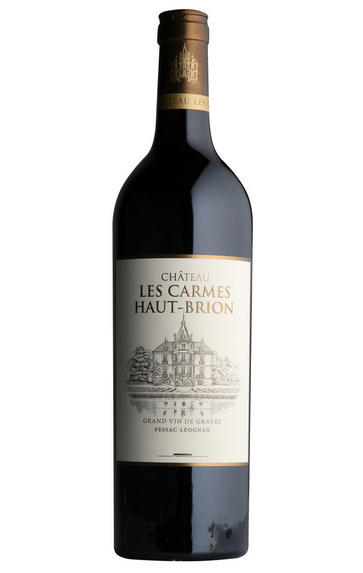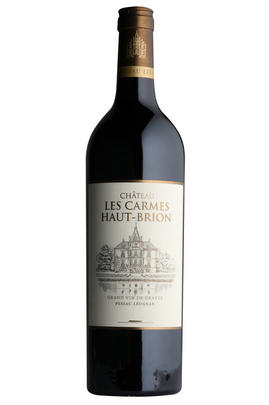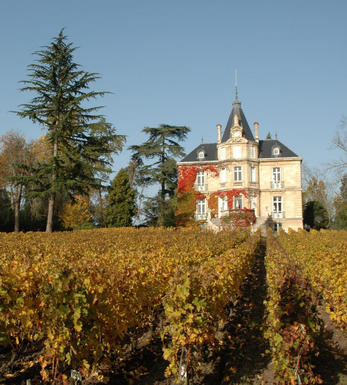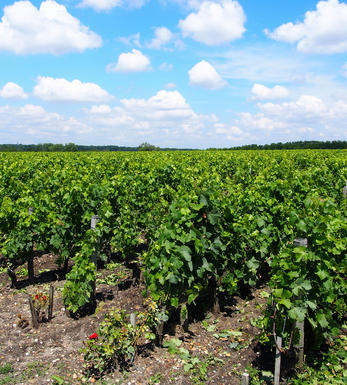
2015 Château les Carmes Haut-Brion, Pessac-Léognan, Bordeaux

Critics reviews
The 2015 Les Carmes Haut-Brion is the first vintage vinified with 100% infusion, including 55% whole bunches. This has a much more intense bouquet compared to the 2014: copious blackberries, blueberry and crushed violet scents, hints of blood orange and a light cassis touch with time. The palate is medium-bodied with fine density and precision, good grip, and edgy tannins with clearly more mineralité percolating through the finish. Excellent. Tasted at the Les Carmes Haut-Brion vertical at the château.
Drink 2023 - 2050
Neal Martin, Vinous.com (October 2022)
The blend is 44% Cabernet Franc, 32% Merlot and 24% Cabernet Sauvignon.
Once again, Les Carmes Haut-Brion stakes its place as one of the most distinctive wines being made in Bordeaux. The 2015 exudes richness, power and intensity. Layers of dark red stone fruit, cedar, tobacco, smoke and pomegranate build up as the wine shows off its voluptuous personality. Les Carmes Haut-Brion stands out for many reasons, including its high percentage of Cabernet Franc, which is unusual in Pessac.
In 2015, winemaker Guillaume Poutier also added a dollop of whole clusters to give the wine more aromatic lift. The use of whole clusters is of course quite common in Burgundy and the Rhône (where Poutier formerly made the wines at Chapoutier), but is very rarely seen in Bordeaux. This full-throttle Pessac will drink well for decades, but it also needs time to shed some of its considerable baby fat. I tasted it three times.
Antonio Galloni, Vinous.com (April 2016)
3.7ph, 40% new oak.
The succulent depth and width of this wine are clear as soon as your nose hovers over the glass. Concentrated tannins hum underneath a more sculpted aerian side of fragrant peonies and raspberry leaf that take off through the palate. This was a warm vintage and we are on a warm site here, and yet you feel a freshness, with crushed mint leaf and juicy cranberry that belies the vintage and speaks to deft winemaking. This is the point at which Carmes begins to fully take on its own personality that is not necessarily reflective of the appellation as a whole.
Drink 2024 - 2044
Jane Anson, JaneAnson.com (February 2022)
The 2015 Les Carmes Haut-Brion is a blend of 44% Cabernet Franc, 32% Merlot and 24% Cabernet Sauvignon, aged 24 months in 80% new and 20% one-year-old oak.
Deep garnet-purple coloured, it has pronounced notes of crushed black and red currants, warm blackberries and black pepper with touches of cedar chest, pencil lead and tilled soil. Medium-bodied, very fine and with plenty of black and red fruit layers, it has a plush backbone and seamless acid, finishing earthy.
Drink 2021 - 2039
Lisa Perrotti-Brown, Wine Advocate (February 2018)
44% Cabernet Franc, 32% Merlot, 24% Cabernet Sauvignon. 60% whole-bunch vinification. First vintage vinified in the new cellar. Aged 24 months in new oak barrel (80%), foudre (10%) and amphora (10%)
Deep crimson hue. Rich and ripe with berry-fruit notes on the nose, though not yet fully expressive. Full and large on attack then refocuses on the finish with length and drive. Texture smooth and suave. Abundant tannin but the tannins finely honed so no aggression. Rich but polished and balanced.
Drink 2023 - 2040
James Lawther MW, JancisRobinson.com (August 2022)
Very polished and poised with an immensely powerful core of tannin that drives incredible length on the palate. Fruits are deep in the dark berry spectrum, encapsulating a terrific sense of freshness through the finish. Great wine.
Try from 2024
James Suckling, JamesSuckling.com (December 2018)
About this WINE

Château les Carmes Haut-Brion
Château les Carmes Haut-Brion is a 10.3-hectare wine estate in Pessac-Léognan on the Left Bank of Bordeaux. The property was established over 400 years ago. It takes its name from the Carmelites, the order of monks that tended it for almost 200 years. Once a little-known neighbour of the world-famous Châteaux Haut-Brion and La Mission Haut-Brion, things have changed rapidly here in recent years and it is today one of Bordeaux’s most exciting names. In 2010, the estate was acquired by Patrice Pichet, a French property developer. He quickly enlisted the dynamic Guillaume Pouthier as winemaker and director, and this has been a truly hot property ever since.
The wine here is stylistically unique within Bordeaux. This is in part due to the vineyard: the estate sits just outside the city of Bordeaux, with some limestone soils to complement the more typical gravel and clay. There is a high proportion of old-vine Cabernet Franc, rarely seen to any great extent on the Left Bank. The team has worked very hard to understand the specificities of each plot and sub-plot, enabling them to react to specific needs – but only where necessary.
Guillaume Pouthier is also a serial innovator. He is a proponent of whole-bunch fermentation, which is virtually unheard of in Bordeaux. Extraction, an important winemaking process, is handled differently here too: Guillaume uses a very gentle method of infusion rather than the more typical pumping-over or punching-down. The wines are matured in a combination of new French oak barrels, large oak casks and amphorae.

Pessac-Leognan
In 1986 a new communal district was created within Graves, in Bordeaux, based on the districts of Pessac and Léognan, the first of which lies within the suburbs of the city. Essentially this came about through pressure from Pessac-Léognan vignerons, who wished to disassociate themselves from growers with predominately sandy soils further south in Graves.
Pessac-Léognan has the best soils of the region, very similar to those of the Médoc, although the depth of gravel is more variable, and contains all the classed growths of the region. Some of its great names, including Ch. Haut-Brion, even sit serenely and resolutely in Bordeaux's southern urban sprawl.
The climate is milder than to the north of the city and the harvest can occur up to two weeks earlier. This gives the best wines a heady, rich and almost savoury character, laced with notes of tobacco, spice and leather. Further south, the soil is sandier with more clay, and the wines are lighter, fruity and suitable for earlier drinking.
Recommended Châteaux: Ch. Haut-Brion, Ch. la Mission Haut-Brion, Ch. Pape Clément, Ch Haut-Bailly, Domaine de Chevalier, Ch. Larrivet-Haut-Brion, Ch. Carmes Haut-Brion, Ch. La Garde, Villa Bel-Air.

Cabernet Sauvignon Blend
Cabernet Sauvignon lends itself particularly well in blends with Merlot. This is actually the archetypal Bordeaux blend, though in different proportions in the sub-regions and sometimes topped up with Cabernet Franc, Malbec, and Petit Verdot.
In the Médoc and Graves the percentage of Cabernet Sauvignon in the blend can range from 95% (Mouton-Rothschild) to as low as 40%. It is particularly suited to the dry, warm, free- draining, gravel-rich soils and is responsible for the redolent cassis characteristics as well as the depth of colour, tannic structure and pronounced acidity of Médoc wines. However 100% Cabernet Sauvignon wines can be slightly hollow-tasting in the middle palate and Merlot with its generous, fleshy fruit flavours acts as a perfect foil by filling in this cavity.
In St-Emilion and Pomerol, the blends are Merlot dominated as Cabernet Sauvignon can struggle to ripen there - when it is included, it adds structure and body to the wine. Sassicaia is the most famous Bordeaux blend in Italy and has spawned many imitations, whereby the blend is now firmly established in the New World and particularly in California and Australia.


Buying options
Add to wishlist
Description
44% Cabernet Franc, 32% Merlot, 24% Cabernet Sauvignon.
The new cellar, winery and tasting room is now open at Les Carmes and it really is quite an astounding building. The 2015 is a pretty powerful wine, serious, complex and very interesting indeed. The floral bouquet is very pretty, layered with really ripe raspberries which are ever so attractive. My favourite aspect of the wine has to be the earthy, mineral character though, as well as the brilliant tannic structure.
The gravelly soils offer a lovely character and the wine has a sense of place, of terroir. Light in the mouth, the tobacco, sweet black fruits and creamy texture create a wonderful palate, but the savoury characteristics are what I enjoy most about this wine. It is another really promising wine for this up and coming estate.
Berry Bros. & Rudd
wine at a glance
Delivery and quality guarantee